Nuremberg trials
49°27.2603′N 11°02.9103′E / 49.4543383°N 11.0485050°E The Nuremberg trials were a series of trials, or tribunals, most notable for the prosecution of prominent members of the political, military, and economic leadership of Nazi Germany after its defeat in World War II. The trials were held in the city of Nuremberg, Germany, from 1945 to 1946, at the Palace of Justice. The first and best known of these trials was the Trial of the Major War Criminals before the International Military Tribunal (IMT), which tried 22 of the most important captured leaders of Nazi Germany. It was held from 21 November 1945, to 1 October 1946. The second set of trials of lesser war criminals was conducted under Control Council Law No. 10 at the U.S. Nuremberg Military Tribunals (NMT); among them included the Doctors' Trial and the Judges' Trial. This article primarily deals with the IMT; see the Subsequent Nuremberg Trials for details on those trials.
Critics[1] of the Nuremberg trials argued that the charges against the defendants were only defined as "crimes" after they were committed and that therefore the trial was invalid as a form of "victors' justice".[2] As Biddiss[3] noted "...the Nuremberg Trial continues to haunt us....It is a question also of the weaknesses and strengths of the proceedings themselves. The undoubted flaws rightly continue to trouble the thoughtful."[4][5]
Origin
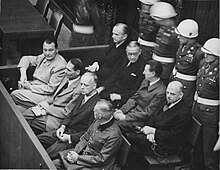
British War Cabinet documents, released on 2 January 2006, have shown that as early as December 1944, the Cabinet had discussed their policy for the punishment of the leading Nazis if captured. British Prime Minister Sir Winston Churchill had then advocated a policy of summary execution in some circumstances with the use of an Act of Attainder to circumvent legal obstacles, and was only dissuaded from this by talks with U.S. leaders later in the war. In late 1943, during the Tripartite Dinner Meeting at the Tehran Conference, the Soviet leader, Joseph Stalin, proposed executing 50,000–100,000 German staff officers. U.S. President Franklin D. Roosevelt joked that perhaps 49,000 would do. Churchill denounced the idea of "the cold blooded execution of soldiers who fought for their country." However, he also stated that war criminals must pay for their crimes and that in accordance with the Moscow Document which he himself had written, they should be tried at the places where the crimes were committed. Churchill was vigorously opposed to executions "for political purposes."[6][7]
U.S. Treasury Secretary, Henry Morgenthau, Jr., suggested a plan for the total denazification of Germany; this was known as the Morgenthau Plan. The plan advocated the forced de-industrialization of Germany, along with forced labour and other draconian measures similar to those that the Nazis themselves had planned for Eastern Europe. Roosevelt initially supported this plan, and managed to convince Churchill to support it in a less drastic form. Later, details were leaked to the public, generating widespread protest. Roosevelt, seeing strong public disapproval, abandoned the plan, but did not proceed to adopt support for another position on the matter. The demise of the Morgenthau Plan created the need for an alternative method of dealing with the Nazi leadership. The plan for the "Trial of European War Criminals" was drafted by Secretary of War Henry L. Stimson and the War Department. Roosevelt died in April 1945. The new president, Harry S. Truman, gave strong approval for a judicial process.
After a series of negotiations between the U.S., Britain, the Soviet Union, and France, details of the trial were worked out. The trials were set to commence on 20 November 1945, in the city of Nuremberg.
Creation of the courts

On January 14, 1942, representatives from the nine occupied countries met in London to draft the Inter-Allied Resolution on German War Crimes. At the meetings in Tehran (1943), Yalta (1945) and Potsdam (1945), the three major wartime powers, the United States, Soviet Union and the United Kingdom, agreed on the format of punishment for those responsible for war-crimes during World War II. France was also awarded a place on the tribunal.
The legal basis for the trial was established by the London Charter, issued on 8 August 1945, which restricted the trial to "punishment of the major war criminals of the European Axis countries." Some 200 German war crimes defendants were tried at Nuremberg, and 1,600 others were tried under the traditional channels of military justice. The legal basis for the jurisdiction of the court was that defined by the Instrument of Surrender of Germany, political authority for Germany had been transferred to the Allied Control Council, which having sovereign power over Germany could choose to punish violations of international law and the laws of war. Because the court was limited to violations of the laws of war, it did not have jurisdiction over crimes that took place before the outbreak of war on 3 September 1939.
Allied war crimes
The war crimes tribunal tried and punished personnel only from Axis countries. Accusations arose claiming victor's justice, since Allied war crimes could not be tried.[citation needed] It is, however, usual that the armed forces of a civilised country[8] issue their forces with detailed guidance on what is and is not permitted under their military code. These are drafted to include any international treaty obligations and the customary laws of war. For example, at the trial of Otto Skorzeny, his defence was in part based on the Field Manual published by the War Department of the United States Army, on 1 October 1940, and the American Soldiers' Handbook.[9] If a member of the armed forces breaks their own military code then they can expect to face a court martial. When members of the Allied armed forces broke their military codes, they could be and were tried, as, for example, at the Biscari Massacre trials.
However, General Chuck Yeager writes in his autobiography that some air corps missions were probably war crimes, (specifically, the 'shoot anything that moves' missions in the German countryside) but he, and other pilots, went on the missions in order to avoid court martial for disobeying orders. He also said he hoped the allies won the war, otherwise they might be tried for war crimes.[10]
The unconditional surrender of the Axis powers was unusual and led directly to the formation of the international tribunals. Usually, international wars end conditionally and the treatment of suspected war criminals makes up part of the peace treaty. In most cases those who are not prisoners of war are tried under their own judicial system if they are suspected of committing war crimes – as happened to some Finns at the end of the concurrent Finnish-Soviet Continuation War. In restricting the international tribunal to trying suspected Axis war crimes, the Allies were acting within normal international law.
Location
The Soviet Union had wanted the trials to take place in Berlin, but Nuremberg was chosen as the site for the trials for specific reasons:
- The Palace of Justice was spacious and largely undamaged (one of the few that had remained largely intact through extensive Allied bombing of Germany). A large prison was also part of the complex.
- Nuremberg was considered the ceremonial birthplace of the Nazi Party, and hosted annual propaganda rallies. It was thus a fitting place to mark the party's symbolic demise.
It was also agreed that France would become the permanent seat of the IMT and that the first trial (several were planned) would take place in Nuremberg.
Participants
Each of the four countries provided one judge and an alternate, as well as the prosecutors. The judges were:
- Major-General Iona Nikitchenko (Soviet main)
- Lieutenant-Colonel Alexander Volchkov (Soviet alternate)
- Rt. Hon. Col. Sir Geoffrey Lawrence (British main and president)
- Sir Norman Birkett (British alternate)
- Francis Biddle (US main)
- John Parker (US alternate)
- Professor Henri Donnedieu de Vabres (French main)
- Robert Falco (French alternate)
The chief prosecutors were Robert H. Jackson for the United States, Sir Hartley Shawcross for the UK, Lieutenant-General R. A. Rudenko for the Soviet Union, and François de Menthon and Auguste Champetier de Ribes for France. Assisting Jackson was the lawyer Telford Taylor and a young US Army translator named Richard Sonnenfeldt. Assisting Shawcross were Major Sir David Maxwell-Fyfe and Sir John Wheeler-Bennett. Mervyn Griffith-Jones, later to become famous as the chief prosecutor in the Lady Chatterley's Lover obscenity trial, was also on Shawcross's team. Shawcross also recruited a young barrister, Anthony Marreco, who was the son of a friend of his, to help the British team with the heavy workload. Robert Falco was an experienced judge who had tried many in court in France.
Democrat James B. Donovan was assistant trial counsel.
The main trial

The International Military Tribunal was opened on 18 October 1945, in the Palace of Justice in Nuremberg. The first session was presided over by the Soviet judge, Nikitchenko. The prosecution entered indictments against 24 major war criminals and six criminal organizations - the leadership of the Nazi party, the Schutzstaffel (SS) and Sicherheitsdienst (SD), the Gestapo, the Sturmabteilung (SA) and the High Command of the German armed forces (OKW).
The indictments were for:
- Participation in a common plan or conspiracy for the accomplishment of crime against peace
- Planning, initiating and waging wars of aggression and other crimes against peace
- War crimes
- Crimes against humanity
The 24 accused were:
"I" indicted "G" indicted and found guilty "O" Charged
| Name | Count | Penalty | Notes | |||
|---|---|---|---|---|---|---|
| 1 | 2 | 3 | 4 | |||
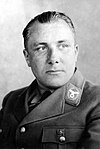 |
I | O | G | G | Death | Successor to Hess as Nazi Party Secretary. Sentenced to death in absentia. Remains found in 1972 and dated to 1945.[11] |
 |
I | G | G | O | 10 years | Leader of the Kriegsmarine from 1943, succeeded Raeder. Initiator of the U-boat campaign. Became President of Germany following Hitler's death.[12] In evidence presented at the trial of Karl Dönitz on his orders to the U-boat fleet to breach the London Rules, Admiral Chester Nimitz stated that unrestricted submarine warfare was carried on in the Pacific Ocean by the United States from the first day that nation entered the war. Dönitz was found guilty of breaching the 1936 Second London Naval Treaty, but his sentence was not assessed on the ground of his breaches of the international law of submarine warfare.[13] |
| I | O | G | G | Death | Reich Law Leader 1933-1945 and Governor-General of the General Government in occupied Poland 1939-1945. Expressed repentance.[14] | |
 |
I | G | G | G | Death | Hitler's Minister of the Interior 1933-1943 and Reich Protector of Bohemia-Moravia 1943-1945. Authored the Nuremberg Race Laws.[15] |
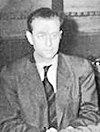 |
I | I | I | O | Acquitted | Popular radio commentator, and head of the news division of the Nazi Propaganda Ministry. Tried in place of Joseph Goebbels.[16] |
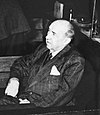 |
I | G | G | G | Life Imprisonment | Hitler's Minister of Economics. Succeeded Schacht as head of the Reichsbank. Released due to ill health on 16 May 1957.[17] |
| G | G | G | G | Death | Reichsmarschall, Commander of the Luftwaffe 1935-1945, Chief of the 4-Year Plan 1936-1945, and several departments of the SS. Second only to Hitler in the Nazi hierarchy during the last years of the war. Committed suicide the night before his execution.[18] | |
| G | G | I | I | Life Imprisonment | Hitler's deputy, flew to Scotland in 1941 in attempt to broker peace with Great Britain. After trial, committed to Spandau Prison; died in 1987.[19] | |
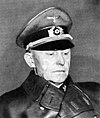 |
G | G | G | G | Death | Wehrmacht Generaloberst, Keitel's subordinate and Chief of the O.K.W.'s Operations Division 1938-1945. Subsequently exonerated by German court in 1953, though the exoneration was later overturned, largely as a result of pressure by American officials.[20] |
 |
I | O | G | G | Death | Highest surviving SS-leader. Chief of RSHA 1943-45, the central Nazi intelligence organ. Also commanded many of the Einsatzgruppen and several concentration camps.[21] |
| G | G | G | G | Death | Head of Oberkommando der Wehrmacht (OKW) 1938-1945.[22] | |
 |
I | I | I | ---- | Major Nazi industrialist. C.E.O of Krupp A.G 1912-45. Medically unfit for trial {died January 16, 1950}. The prosecutors attempted to substitute his son Alfried (who ran Krupp for his father during most of the war) in the indictment, but the judges rejected this as being too close to trial. Alfried was tried in a separate Nuremberg trial for his use of slave labor, thus escaping the worst notoriety and possibly death. | |
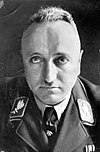 |
I | I | I | I | ---- | Head of DAF, The German Labour Front. Suicide on 25 October 1945, before the trial began |
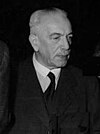 Baron Konstantin von Neurath |
G | G | G | G | 15 years | Minister of Foreign Affairs 1932-1938, succeeded by Ribbentrop. Later, Protector of Bohemia and Moravia 1939-43. Resigned in 1943 due to dispute with Hitler. Released (ill health) 6 November 1954.[23] |
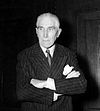 |
I | I | O | O | Acquitted | Chancellor of Germany in 1932 and Vice-Chancellor under Hitler in 1933-1934. Ambassador to Austria 1934-38 and ambassador to Turkey 1939-1944. Although acquitted at Nuremberg, von Papen was reclassified as a war criminal in 1947 by a German de-Nazification court, and sentenced to eight years' hard labour. He was acquitted following appeal after serving two years.[24] |
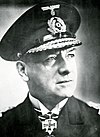 |
G | G | G | O | Life Imprisonment | Commander In Chief of the Kriegsmarine from 1928 until his retirement in 1943, succeeded by Dönitz. Released (ill health) 26 September 1955.[25] |
 |
G | G | G | G | Death | Ambassador-Plenipotentiary 1935-1936. Ambassador to the United Kingdom 1936-1938. Nazi Minister of Foreign Affairs 1938-1945,[26] |
 |
G | G | G | G | Death | Racial theory ideologist. Later, Minister of the Eastern Occupied Territories 1941-1945.[27] |
 |
I | I | G | G | Death | Gauleiter of Thuringia 1927-1945. Plenipotentiary of the Nazi slave labor program 1942-1945.[28] |
 |
I | I | O | O | Acquitted | Prominent banker and economist. Pre-war president of the Reichsbank 1923-1930 & 1933-1938 and Economics Minister 1934-1937. Admitted to violating the Treaty of Versailles.[29] |
| I | O | O | G | 20 years | Head of the Hitlerjugend from 1933 to 1940, Gauleiter of Vienna 1940-1943. Expressed repentance.[30] | |
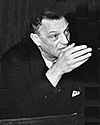 |
I | G | G | G | Death | Instrumental in the Anschluss and briefly Austrian Chancellor 1938. Deputy to Frank in Poland 1939-1940. Later, Reich Commissioner of the occupied Netherlands 1940-1945. Expressed repentance.[31] |
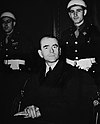 |
I | I | G | G | 20 Years | Hitler's favorite architect and close friend, and Minister of Armaments from 1942. In this capacity, he was ultimately responsible for the use of slave labourers from the occupied territories in armaments production. Expressed repentance.[32] |
 |
I | O | O | G | Death | Gauleiter of Franconia 1922-1940. Publisher of the weekly newspaper, Der Stürmer.[33] |
"I" indicted "G" indicted and found guilty "O" Charged
Throughout the trials, specifically between January and July 1946, the defendants and a number of witnesses were interviewed by American psychiatrist Leon Goldensohn. His notes detailing the demeanour and personality of the defendants survive.
The death sentences were carried out 16 October 1946 by hanging using the standard drop method instead of long drop.[34][35] The executioner was John C. Woods. The bodies were brought to Dachau and burned (the final use of the crematories there) with the ashes then scattered into a river.[citation needed] The French judges suggested the use of a firing squad for the military condemned, as is standard for military courts-martial, but this was opposed by Biddle and the Soviet judges. These argued that the military officers had violated their military ethos and were not worthy of the firing squad, which was considered to be more dignified.[citation needed] The prisoners sentenced to incarceration were transferred to Spandau Prison in 1947.
Of the twelve defendants sentenced to death by hanging, two were not hanged: Hermann Göring committed suicide the night before the execution and Martin Bormann was not present when convicted. The remaining ten defendants sentenced to death were hanged.
The definition of what constitutes a war crime is described by the Nuremberg Principles, a set of guidelines document which was created as a result of the trial. The medical experiments conducted by German doctors and prosecuted in the so-called Doctors' Trial led to the creation of the Nuremberg Code to control future trials involving human subjects, a set of research ethics principles for human experimentation.
Of the organizations the following were found not to be criminal:
Subsidiary and related trials
This section needs expansion. You can help by adding to it. (May 2008) |
Assessment
In 1945 the idea of an International Military Tribunal was unprecedented. Creating a forum to legitimately try enemy prisoners under a fair legal system had never been attempted and many questioned whether World War II was the time to try it.[citation needed] The governments of the Allies and France believed that a trial, following an established legal system, was a better option than military execution without due process. Consequently, the IMT was formed to try Nazi war criminals.
Although the IMT had its flaws, it at least provided the Nazi defendants with a modicum of justice by virtue of the simple fact that they were allowed a trial. The Allies overcame the urge to indiscriminately execute every prisoner they took and inside decided to subject them to the rule of law.
Legacy
The creation of the IMT was followed by trials of lesser Nazi officials, trials of Nazi doctors, who performed horrifying experiments on people in prison camps. It served as the model for the International Military Tribunal for the Far East which tried Japanese officials for crimes against peace and against humanity. It also served as the model for the Eichmann tria and for present-day courts at The Hague, for trying crimes committed during the Balkan wars of the early 1990s, and at Arusha, for trying the people responsible for the genocide in Rwanda.
The Nuremberg trials had a great influence on the development of international criminal law. The Conclusions of the Nuremberg trials served as models for:
- The Genocide Convention, 1948.
- The Universal Declaration of Human Rights, 1948.
- The Nuremberg Principles, 1950.
- The Convention on the Abolition of the Statute of Limitations on War Crimes and Crimes against Humanity, 1968.
- The Geneva Convention on the Laws and Customs of War, 1949; its supplementary protocols, 1977.
The International Law Commission, acting on the request of the United Nations General Assembly, produced in 1950 the report Principles of International Law Recognized in the Charter of the Nürnberg Tribunal and in the Judgement of the Tribunal (Yearbook of the International Law Commission, 1950, vol. II[36]). See Nuremberg Principles.
The influence of the tribunal can also be seen in the proposals for a permanent international criminal court, and the drafting of international criminal codes, later prepared by the International Law Commission.
Establishment of a permanent International Criminal Court
The Nuremberg trials initiated a movement for the prompt establishment of a permanent international criminal court, eventually leading over fifty years later to the adoption of the Statute of the International Criminal Court.
Criticism
Chief Justice of the United States Harlan Fiske Stone called the Nuremberg trials a fraud. "(Chief US prosecutor) Jackson is away conducting his high-grade lynching party in Nuremberg," he wrote. "I don't mind what he does to the Nazis, but I hate to see the pretense that he is running a court and proceeding according to common law. This is a little too sanctimonious a fraud to meet my old-fashioned ideas."[37]
Associate Supreme Court Justice William O. Douglas charged that the Allies were guilty of "substituting power for principle" at Nuremberg. "I thought at the time and still think that the Nuremberg trials were unprincipled," he wrote. "Law was created ex post facto to suit the passion and clamor of the time."[38]
The validity of the court has been questioned for a variety of reasons:
- The defendants were not allowed to appeal or affect the selection of judges. A. L. Goodhart, Professor at Oxford, opposed the view that, because the judges were appointed by the victors, the Tribunal was not impartial and could not be regarded as a court in the true sense. He wrote:[39]
- "Attractive as this argument may sound in theory, it ignores the fact that it runs counter to the administration of law in every country. If it were true then no spy could be given a legal trial, because his case is always heard by judges representing the enemy country. Yet no one has ever argued that in such cases it was necessary to call on neutral judges. The prisoner has the right to demand that his judges shall be fair, but not that they shall be neutral. As Lord Writ has pointed out, the same principle is applicable to ordinary criminal law because 'a burglar cannot complain that he is being tried by a jury of honest citizens.'"
- The main Soviet judge, Nikitchenko, had taken part in Stalin's show trials of 1936-1938,[40].
- One of the charges, brought against Keitel, Jodl, and Ribbentrop included conspiracy to commit aggression against Poland in 1939. The Secret Protocols of the German-Soviet Non-Aggression Pact of 23 August 1939, proposed the partition of Poland between the Germans and the Soviets (which was subsequently executed in September 1939); however, Soviet leaders were not tried for being part of the same conspiracy.[41] Instead, the Tribunal falsely proclaimed the Secret Protocols of the Non-Aggression Pact to be a forgery. Moreover, Allied Powers Britain and Soviet Union were not tried for preparing and conducting the Anglo-Soviet invasion of Iran and the Winter War, respectively.
- In 1915, the Allied Powers, Britain, France, and Russia, jointly issued a statement explicitly charging, for the first time, another government (the Sublime Porte) of committing "a crime against humanity". However it was not until the phrase was further developed in the London Charter that it had a specific meaning. As the London Charter definition of what constituted a crime against humanity was unknown when many of the crimes were committed, it could be argued to be a retrospective law, in violation of the principles of prohibition of ex post facto laws and the general principle of penal law nullum crimen, nulla poena sine praevia lege poenali.[42]
- The court agreed to relieve the Soviet leadership from attending these trials as war criminals in order to hide their crimes against war civilians, crimes that were committed by their army that included "carving up Poland in 1939 and attacking Finland three months later." This "exclusion request" was initiated by the Russians and subsequently approved by the court's administration.[43]
- The trials were conducted under their own rules of evidence; the indictments were created ex post facto and were not based on any nation's law; the tu quoque defense was removed; and some claim the entire spirit of the assembly was "victor's justice". The Charter of the International Military Tribunal permitted the use of normally inadmissible "evidence." Article 19 specified that "The Tribunal shall not be bound by technical rules of evidence... and shall admit any evidence which it deems to have probative value". Article 21 of the Nuremberg International Military Tribunal (IMT) Charter stipulated:
- "The Tribunal shall not require proof of facts of common knowledge but shall take judicial notice thereof. It shall also take judicial notice of official governmental documents and reports of the United [Allied] Nations, including acts and documents of the committees set up in the various allied countries for the investigation of war crimes, and the records and findings of military and other Tribunals of any of the United [Allied] Nations"
- The chief Soviet prosecutor submitted false documentation in an attempt to indict defendants for the murder of thousands of Polish officers in the Katyn forest near Smolensk. However, the other Allied prosecutors refused to support the indictment and German lawyers promised to mount an embarrassing defense. No one was charged nor found guilty at Nuremberg for the Katyn Forest massacre.[44] In 1990, the Soviet government acknowledged that the Katyn massacre was carried out, not by the Germans, but by the Soviet secret police.[45]
- Freda Utley, in her 1949 book "The High Cost of Vengeance"[1] charged the court with amongst other things double standards. She pointed to the Allied use of civilian forced labor, and deliberate starvation of civilians[46][47] in the occupied territories. She also noted that General Rudenko, the chief Soviet prosecutor, after the trials became commandant of the Sachsenhausen concentration camp. (After the fall of East Germany the bodies of 12,500 Soviet era victims were uncovered at the camp, mainly "children, adolescents and elderly people."[48])
However, as described above, the unconditional surrender of the Axis powers was unusual and led directly to the formation of the international tribunals. In most cases those who are not prisoners of war are tried under their own judicial system if they are suspected of committing war crimes; in restricting the international tribunal to trying suspected Axis war crimes, the Allies were acting within normal international law.
Moreover, the Tribunal itself strongly disputed that the London Charter was ex post facto law, pointing to existing international agreements signed by Germany that made aggressive war and certain wartime actions unlawful, such as the Kellogg-Briand Pact, the Covenant of the League of Nations, and the Hague Conventions.[49]
Additionally, many commentators felt the Nuremberg Trials represented a step forward in extending fairness to the vanquished by requiring that actual criminal misdeeds be proved before punishment could ensue; including some of the defendants and their legal team:
- Perhaps the most telling responses to the critics of Jackson and Nuremberg were those of the defendants at trial. Hans Frank, the defendant who had served as the Nazi Governor General of occupied Poland, stated, “I regard this trial as a God-willed court to examine and put an end to the terrible era of suffering under Adolf Hitler.” With the same theme, but a different emphasis, defendant Albert Speer, Hitler’s war production minister, said, “This trial is necessary. There is a shared responsibility for such horrible crimes even in an authoritarian state.” Dr. Theodore Klefish, a member of the German defense team, wrote: "It is obvious that the trial and judgment of such proceedings require of the tribunal the utmost impartiality, loyalty and sense of justice. The Nuremberg tribunal has met all these requirements with consideration and dignity. Nobody dares to doubt that it was guided by the search for truth and justice from the first to the last day of this tremendous trial."[50]
Legitimacy
One criticism that was made of the IMT was that some treaties were not binding on the Axis powers because they were not signatories. This was addressed in the judgment relating to war crimes and crimes against humanity[51] contains an expansion of customary law "the Convention Hague 1907 expressly stated that it was an attempt 'to revise the general laws and customs of war,' which it thus recognised to be then existing, but by 1939 these rules laid down in the Convention were recognised by all civilised nations, and were regarded as being declaratory of the laws and customs of war which are referred to in Article 6 (b) of the [London] Charter." The implication under international law is that if enough countries have signed up to a treaty, and that treaty has been in effect for a reasonable period of time, then it can be interpreted as binding on all nations not just those who signed the original treaty. This is a highly controversial aspect of international law, one that is still actively debated in international legal journals.
But the customary law of war exists, and has existed, since time immemorial; the use of treaty to codify what is allowed and what is prohibited is merely its modern expression; just as the common law in the English-speaking nations has forbidden murder, under pain of death, since its inception, without a word on the statute-books proscribing murder in many of the common law countries up to the present day. The idea that there are certain expectations of those practicing the profession of arms among the civilized nations has been ingrained in many cultures--including those of Europe, East Asia (c.f. bushido, the warrior code of Japan), the Middle East (c.f. Saladin, the Arabian/Islamic exemplar of knightly virtue, respected and honored across the battle-lines by the Crusaders), and other civilizations. In particular, the culture of Europe gave rise to the concept of chivalry, the code of honor regulating the conduct of knights, men-at-arms, and in later days, in more modern forms, soldiers. Traditionally, in Europe and elsewhere, the obligation of the warrior is to levy war upon all those who bear arms against him, his brothers-in-arms, his commander, and his nation, using whatever means at his disposal are necessary and honorable for the task, and not using those which are dishonorable or perfidious, but in so doing, to save and to defend the innocent, the weak, and the helpless; to bring succor to the wounded, comfort to the dying; to spare from the rigors of war those who do not present a threat, not bearing arms against him; to give quarter, and to treat with humanity and military dignity the enemy soldier who has yielded, or is incapacitated; and, above all, to protect women and children from the sword.
The idea that a warrior owes a duty not just to his nation, or his army, but also to his common humanity is a concept as old as civilization itself is. Over the millennia, civilization has remembered with respect those warriors who were courageous in battle and merciful to those they defeated, regardless of whose banner under which they fought,[52] while history regards with infamy those warriors, regardless of their military success, who willingly discarded the very honor and respect that they may have earned in battle through their atrocities committed upon civilians or cruelties visited upon vanquished foes. No warrior has been regarded as a man of courage for slaughtering of the weak or innocent, for his pillages or sacks, or for brutalities and barbarities he visited upon his foes; therein lies no honor or glory, only senseless cruelty. This indicates that just as the law against murder in the common-law nations is established not by statute, but by history, custom, the human condition, and by being immanent in Nature, so too is the law of war, and so too has it always been, whether its violation is explicitly prohibited by treaty or not.
Notes
- ^ See, e.g., Zolo(Victors' Justice (2009) by Danilo Zolo, Professor of Philosophy and Sociology of Law at the University of Florence. See also Institute for Historical Review, Not Guilty at Nuremberg: The German Defense Case, as well as David Irving, Nuremberg, The Last Battle
- ^ See, e.g., statement of Professor Nicholls of St. Antony's College, Oxford, that "[t]he Nuremberg trials have not had a very good press. The are often depicted as a form of victors' justice in which people were tried for crimes which did not exist in law when they committed them, such as conspiring to start a war."Prof. Anthony Nicholls, University of Oxford
- ^ "Victors' Justice: The Nuremberg Tribunal," by Michael Biddiss, History Today, Vol. 45, May 1995
- ^ See, e.g., BBC Article for BBC by Prof. Richard Overy("[T]hat the war crimes trials ... were expressions of a legally dubious 'victors' justice' was [a point raised by] ...senior [Allied] legal experts who doubted the legality of the whole process....There was no precedent. No other civilian government had ever been put on trial by the authorities of other states....What the Allied powers had in mind was a tribunal that would make the waging of aggressive war, the violation of sovereignty and the perpetration of what came to be known in 1945 as 'crimes against humanity' internationally recognised offences. Unfortunately these had not previously been defined as crimes in international law, which left the Allies in the legally dubious position of having to execute retrospective justice - to punish actions that were not regarded as crimes at the time they were committed.")
- ^ See Paper of Jonathan Graubart, San Diego State University, Political Science Department, published online Graubart Article, referring to the ex post facto nature of the charges.
- ^ John Crossland Churchill: execute Hitler without trial in The Sunday Times, 1 January, 2006
- ^ Tehran Conference: Tripartite Dinner Meeting November 29, 1943 Soviet Embassy, 8:30 PM
- ^ Judgement : The Law Relating to War Crimes and Crimes Against Humanity contained in the Avalon Project archive at Yale Law School. "but by 1939 these rules laid down in the [Hague] Convention [of 1907] were recognised by all civilized nations, and were regarded as being declaratory of the laws and customs of war"
- ^ Trial of Otto Skorzeny and Others, General Military Government Court of the U.S. Zone of Germany, 18 August to 9 September 1947.
- ^ Chuck Yeager and Leo Janos (1986). Yeager, an Autobiography. Bantam. ISBN 0553256742.
- ^ "Bormann judgement".
- ^ "Dönitz judgement".
- ^ President of the Reich for 23 days after Adolf Hitler's suicide.Judgement : Doenitz the Avalon Project at the Yale Law School
- ^ "Frank judgement".
- ^ "Frink judgement".
- ^ "Fritzsche judgement".
- ^ "Funk judgement".
- ^ "Goering judgement".
- ^ "Hess judgement".
- ^ "Jodl judgement".
- ^ "Kaltenbrunner judgement".
- ^ "Keitel judgement".
- ^ "Von Neurath judgement".
- ^ "Von Papen judgement".
- ^ "Raeder judgement".
- ^ "Von Ribbentrop judgement".
- ^ "Rosenberg judgement".
- ^ "Sauckel judgement".
- ^ "Schacht judgement".
- ^ "Von Schirach judgement".
- ^ "Seyss-Inquart judgement".
- ^ "Speer judgement".
- ^ "Streicher judgement".
- ^ "Judgment at Nuremberg" (PDF).
- ^ "The trial of the century".
- ^ "Yearbook of the International Law Commission, 1950". Untreaty.un.org. Retrieved 2009-04-04.
- ^ 'Harlan Fiske Stone: Pillar of the Law', Alpheus T. Mason, (New York: Viking, 1956)
- ^ 'Dönitz at Nuremberg: A Reappraisal', H. K. Thompson, Jr. and Henry Strutz, (Torrance, Calif.: 1983)
- ^ A. L. Goodhart, "The Legality of the Nuremberg Trials", Juridical Review, April, 1946.
- ^ Conquest, Robert The Great Terror A Reassessment London: Oxford University Press, 1990 page 92.
- ^ Bauer, Eddy The Marshall Cavendish Illustrated Encyclopedia of World War II Volume 22 New York: Marshall Cavendish Corporation 1972 page 3071.
- ^ "MOTION ADOPTED BY ALL DEFENSE COUNSEL".
- ^ BBC News. 1945: Nuremberg trial of Nazis begins. November 20, 1945.
- ^ "German Defense Team Clobbers Soviet Claims". Nizkor.org. 1995-08-26. Retrieved 2009-04-04.
- ^ BBC News story : Russia to release massacre files, 16 December 2004 online
- ^ Richard Dominic Wiggers, The United States and the Refusal to Feed German Civilians after World War II
- ^ U.S. military personnel and their wives were under strict orders to destroy or otherwise render inedible their own leftover surplus so as to ensure it could not be eaten by German civilians. Eugene Davidson "The Death and Life of Germany" p.85 University of Missouri Press, 1999 ISBN 0826212492
- ^ "Germans Find Mass Graves at an Ex-Soviet Camp" The New York Times, September 24, 1992
- ^ "International Military Tribunal, Judgment of the International Military Tribunal (1946)".[dead link]
- ^ Robert Jackson and International Human Rights, Professor Henry T. King, Robert H. Jackson Center, 1 May 2003
- ^ Judgement : The Law Relating to War Crimes and Crimes Against Humanity in the Avalon Project archive at Yale Law School
- ^ For example, Erwin Rommel, the extraordinary German commander of armor and infantry during the Second World War, known for both his brilliance and mastery of the military art, as well as his scrupulous respect for the law and custom of war, is today honored, respected, and remembered by both his nation and his former foes, whilst many other German generals from that same war, regardless of their military genius, are remembered by civilization primarily for their crimes.
Further reading
See also
- Command responsibility
- Eichmann in Jerusalem
- Einsatzgruppen Trial
- International Military Tribunal for the Far East
- Judgment at Nuremberg (1961 film)
- List of Axis war criminals
- List of war crimes
- Nazi eugenics
- Nuremberg Defense
- Nuremberg Diary, an account of observations and discussions with the defendants by an American psychologist
- Superior Orders
- Tanya Savicheva
External links
- Official records of the Nuremberg trials (The Blue series) in 42 volumes from the records of the Library of congress
- The Nuremberg Trials Original reports and pictures from The Times
- Official page of the Nuremberg City Museum
- Nuremberg defence doesn't make the grade-The Age newspaper
- Donovan Nuremberg Trials Collection Cornell Law Library
- Nuremberg Trials Project: A digital document collection Harvard Law School Library
- The Avalon Project
- Charter of the International Military Tribunal (Nuremberg trials)
- The Subsequent Nuremberg Trials
- Nizkor Holocaust Web Project
- United States Holocaust Memorial Museum Online Exhibit
- Special focus on The trials - USHMM
- Famous World Trials - Nuremberg Trials
- Nuremberg Trials Gallery
- The Nuremberg Trials: The Defendants and Verdicts
- Nuremberg War Crimes - Trials
- Nuremberg Trials 1945-1949
- "American Experience: The Nuremberg Trials" PBS
- Obituary of Anthony Marreco
- Crimes, Trials and Laws
- Nuremberg Trials
- Nuremberg defendants
- A Tree Fell in the Forest: The Nuremberg Judgments 60 Years On, JURIST
- CBC Radio: A Conversation with Geoffrey Robertson, Author of the Tyrannicide Brief (Feb 18/07) (RealAudio)
- JAG Corps Attorneys
- Attorney Shawcross reads an account of a massacre - 27 July 1946 (BBC) (Windows Media and Real Audio) Warning: graphic descriptions of atrocities
- The Nuremberg Judgments, Chapter 6 from The High Cost of Vengeance, by Freda Utley, Henry Regnery Company, Chicago, (1948). Made available by "The Freda Utley Foundation"
